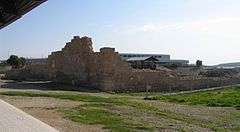Laura of Euthymius
The Laura of Euthymius was a laura in the present-day West Bank founded by Saint Euthymius the Great (377–473) in 420.
| Laura of Euthymius | |
|---|---|
 The Laura of Euthymius | |
 Location within the Palestinian territories | |
| General information | |
| Type | lavra |
| Architectural style | Byzantine |
| Coordinates | 31°49′00.40″N 35°21′31.50″E |
| Palestine grid | 1819/1332 |

Lavra
Under St Euthymius (428-473)
The church was consecrated by Juvenal, Bishop of Jerusalem on 7 May 428.[1] The lavra, a cluster of cells for hermits around a church, was located in Adummim on the road from Jericho to Jerusalem and was based on the layout of the Pharan lavra, with small cells.[2] The vita of the founder, also known as Euthymius of Lesser Armenia, mentions him living his first years as a monk in the Holy Land (406–11) at Pharan.[3]
Byzantine period after Euthymius
Following the death of Euthymius on 20 January 473 the church was converted to a refectory and a new church and cenobium were built above it.[3] The ceonobium was the area that novitiate monks would receive training prior to admittance to a lavra of the Sabaite tradition.[4] The new church was consecrated by Martyrius, Patriarch of Jerusalem, in 482 and the site thereafter became known as the Monastery of St. Euthymius.[5] The lavra, ruined by an earthquake in 660, was rebuilt in a similar manner.[3]
Crusader period
In 1106 Abbot Daniel noted: "To the east of the laura of St. Saba, only behind the mountain, is the Monastery of St. Euthymius, three versts away, and there lies St. Euthymius, and many other holy fathers lie there, and their bodies are as those of living people. There is a little monastery on a level place, and about it are rocky mountains some distance off. The monastery was established with a surrounding wall and the church was elevated. And there is quite close to it the Monastery of St. Theoctistus, under the mountain only half a day’s walk from the Monastery of Euthymius, and all this has been destroyed now by pagans”.[6])
The monastic complex went through a massive restoration and construction phase in the 12th century during the Crusader period, but was finally abandoned in the next century.[3]
Significance
The Laura at Euthymius was essential in the advancement and organisation of the Sabaite (desert monastic) movement,[4] and was central to the development of the non-Chalcedonian orthodoxy and miaphysism within Palestinian monasticism and Oriental Orthodoxy.[7]
Caravanserai (Khan al-Ahmar)
After the abandonment of the monastery in the 13th century, the structures were converted during the same century into a travellers' inn, known as Khan al-Ahmar, a caravanserai for Muslim pilgrims on the route between Jerusalem and Mecca via Nabi Musa.[3]
Access
The site is east of Mishor Adumim, the industrial zone of Ma'ale Adumim, and is accessible to visit.[8]
See also
- Monastery of Martyrius, a ruined Byzantine monastery in nearby Ma'ale Adumim
References
- Denys Pringle (1998). The Churches of the Crusader Kingdom of Jerusalem: L-Z (excluding Tyre). Cambridge University Press. p. 229. ISBN 9780521390378.
- Patrich Joseph (2001) The Sabaite Heritage in the Orthodox Church from the Fifth Century to the Present Peeters Publishers, ISBN 90-429-0976-5 p 342
- Murphy-O'Connor, Jerome (2008) The Holy Land: An Oxford Archaeological Guide from Earliest Times to 1700 Oxford University Press US, ISBN 0-19-923666-6 p. 335
- Patrich, Joseph (1995) Sabas, Leader of Palestinian Monasticism: A Comparative Study in Eastern Monasticism, Fourth to Seventh Centuries Dumbarton Oaks, ISBN 0-88402-221-8 pp 265-266
- Denys Pringle (1993). Op. Cit.. p. 230. ISBN 9780521390378.
- Pozni︠a︡kov, 1889, p. 35, translated by Chitty
- Patrich, Joseph (2001) The Sabaite Heritage in the Orthodox Church from the Fifth Century to the Present Peeters Publishers, ISBN 90-429-0976-5 p 289
- "Euthymius Monastery". Biblewalks.com. Retrieved 5 July 2018.
Bibliography
- Conder, C.R.; Kitchener, H.H. (1883). The Survey of Western Palestine: Memoirs of the Topography, Orography, Hydrography, and Archaeology. 3. London: Committee of the Palestine Exploration Fund. (p. 207)
- Chitty, D.; Jones, A.H.M. (1928). "The Church of St. Euthymius at Khan El-Ahmar, Near Jerusalem". Palestine Exploration Quarterly. 60 (4): 175–179. doi:10.1179/peq.1928.60.4.175.
- Chitty, D. (1932). "The Monastery of St. Euthymius". Palestine Exploration Quarterly. 64 (4): 188–203. doi:10.1179/peq.1932.64.4.188.
- Hirschfeld, Y. (1993). "Euthymius and his monastery in the Judean desert" (PDF). LA. 43: 339–371.
- Pozni︠a︡kov, V., ed. (1889). Itinéraires russes en Orient.
- Pringle, Denys (1998). The Churches of the Crusader Kingdom of Jerusalem: L-Z (excluding Tyre). II. Cambridge University Press. ISBN 0-521-39037-0. (pp. 229-238)
External links
- Euthymius Monastery, Bible walks
- Survey of Western Palestine, Map 18: IAA, Wikimedia commons